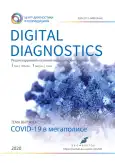The frequency and character of community-acquired pneumonia comparison before and during the COVID-19 epidemic in the multi-specialty hospital
- Authors: Yaremenko S.A.1,2, Rucheva N.A.1, Zhuravlev K.N.1, Sinitsyn V.E.2
-
Affiliations:
- State Moscow Clinical Hospital I.V.Davydovskiy
- Lomonosov Moscow State University
- Issue: Vol 1, No 1 (2020)
- Pages: 37-47
- Section: Original Study Articles
- URL: https://journals.rcsi.science/DD/article/view/46833
- DOI: https://doi.org/10.17816/DD46833
- ID: 46833
Cite item
Abstract
BACKGROUND: The 2019 coronavirus disease outbreak (COVID-19) quickly swept the world in just a month. Polymerase chain reaction (PCR) is used in the diagnosis of this disease, but this test has limitations related to false negative results, as well as PCR is a time-consuming procedure. Under these conditions, chest computed tomography (CT) can become one of the main methods in the Clinician’s Arsenal used for early detection of COVID-19 in patients who first seek medical help.
AIMS: comparison of the frequency of community-acquired pneumonia and its characteristics according to CT data before and during the COVID-19 epidemic and study of the possibilities of their timely detection and differential diagnosis.
MATERIALS AND METHODS: A retrospective analysis of chest CT scans results was performed in Davydovsky hospital (Moscow) from April 1 to April 17, 2020. It included all patients diagnosed with viral pneumonia at the CT. All patients with suspected diagnosis of viral pneumonia underwent PCR testing. Retrospective analysis of chest CT data from patients admitted to the hospital with suspected pneumonia for the same period in 2019 was taken as a comparison group.
RESULTS: For the period from April 1 to April 17, 2020 according to chest CT, pneumonia was diagnosed in 140 cases, of which 65 (46.4%) were described as viral, compared with the same period in 2019 − 7 diagnoses of viral pneumonia (10.3%) were described a significant increase in cases of viral pneumonia (5.723; p <0.01). Results of PCR test in patients with viral pneumonia according to CT data was: positive in 34 (52.3%), negative in 22 (33.8%), 9 (13.9%) patients were not tested. When comparing the frequency of detection on CT of viral pneumonia patterns in patients for the same period of time in 2019 and 2020, no significant differences were found. The probability of COVID-19 due to results of chest CT was: average 13.8%, high − 75.4%. The severity of viral pneumonia according to CT data was: light 38.5%, medium 46.2%, severe 12.3%, extremely severe 3.1%.
CONCLUSIONS: Rapid CT diagnostics of COVID-19, even with false negative results of PCR tests, can help to isolate a patient with suspected COVID-19, start treatment on time and prevent the further spread of viral infection in a pandemic. Nevertheless, due to the non-specificity of the revealed picture, the possibilities of CT to identify lung lesions by specific viral agents are limited.
Keywords
Full Text
##article.viewOnOriginalSite##About the authors
Stepan A. Yaremenko
State Moscow Clinical Hospital I.V.Davydovskiy; Lomonosov Moscow State University
Author for correspondence.
Email: yaremenkosa@yandex.ru
ORCID iD: 0000-0002-7709-977X
MD, PhD student
Russian Federation, MoscowNatalia A. Rucheva
State Moscow Clinical Hospital I.V.Davydovskiy
Email: rna1969@yandex.ru
ORCID iD: 0000-0002-8063-4462
MD, PhD
Russian Federation, MoscowKirill N. Zhuravlev
State Moscow Clinical Hospital I.V.Davydovskiy
Email: kir232@mail.ru
ORCID iD: 0000-0003-1733-267X
MD
Russian Federation, MoscowValentin E. Sinitsyn
Lomonosov Moscow State University
Email: vsini@mail.ru
ORCID iD: 0000-0002-5649-2193
MD, PhD, Professor
Russian Federation, MoscowReferences
- Zhu N, Zhang D, Wang W, et al. A novel coronavirus from patients with pneumonia in China, 2019. N Engl J Med. 2020;382(8):727–733. doi: 10.1056/NEJMoa2001017
- Xie X, Zhong Z, Zhao W, et al. Chest CT for Typical 2019-nCoV Pneumonia: Relationship to Negative RT-PCR Testing. Radiology. 2020;296(2):E41−E4. doi: 10.1148/radiol.2020200343
- World Health Organization. Summary of probable SARS cases with onset of illness from 1 November 2002 to 31 July 2003 (based on data as of December 31, 2003). Available from: https://www.who.int/publications/m/item/summary-of-probable-sars-cases-with-onset-of-illness-from-1-november-2002-to-31-july-2003
- World Health Organization. Naming the coronavirus disease (COVID-2019) and the virus that causes it. Available from: https://www.who.int/emergencies/diseases/novel-coronavirus-2019/technical-guidance/naming-the-coronavirus-disease-(covid-2019)-and-the-virus-that-causes-it
- She J, Jiang J, Ye L, et al. 2019 novel coronavirus of pneumonia in Wuhan, China: emerging attack and management strategies. Clin Transl Med. 2020;9(1):19. doi: 10.1186/s40169-020-00271-z
- Xu X, Chen P, Wang J, et al. Evolution of the novel coronavirus from the ongoing Wuhan outbreak and modeling of its spike protein for risk of human transmission. Sci China Life Sci. 2020;63(3):457–460. doi: 10.1007/s11427-020-1637-5
- Huang C, Wang Y, Li X, et al. Clinical features of patients infected with 2019 novel coronavirus in Wuhan, China. Lancet. 2020;395(10223):497–506. doi: 10.1016/S0140-6736(20)30183-5
- Fang Y, Zhang H, Xie J, et al. Sensitivity of Chest CT for COVID-19: Comparison to RT-PCR. Radiology. 2020; 296(2):E115−E117. doi: 10.1148/radiol.2020200432
- Chung M, Bernheim A, Mei X, et al. CT Imaging of the 2019 Novel Coronavirus (2019-nCoV) Pneumonia. Radiology. 2020. doi: 10.1148/radiol.2020200230
- BSTI. COVID-19 BSTI reporting templates and Codes. Available from: https://www.bsti.org.uk/covid-19-resources/covid-19-bsti-reporting-templates/
- Paul NS, Roberts H, Butany J, et al. Radiologic pattern of disease in patients with severe acute respiratory syndrome: The Toronto experience. Radiographics. 2004;24:553–563. doi: 10.1148/rg.242035193
- Das KM, Lee EY, Langer RD, Larsson SG. Middle East respiratory syndrome coronavirus: What does a radiologist need to know? AJR Am J Roentgenol. 2016;206(6):1193−1201. doi: 10.2214/AJR.15.15363
- Koo HJ, Lim S, Choe J, et al Radiographic and CT features of viral pneumonia. Radiographics. 2018;38(3):719−739. doi: 10.1148/rg.2018170048
- McGonagle D, Sharif K, O’Regan A, Bridgewood C. Interleukin-6 use in COVID-19 pneumonia related macrophage activation syndrome. Autoimmun Rev. 2020;102537. doi: 10.1016/j.autrev.2020.102537
- Colafrancesco S, Priori R, Alessandri C, et al. sCD163 in AOSD : a biomarker for macrophage activation related to hyperferritinemia. Immunol Res. 2014;60(2-3):177−183. doi: 10.1007/s12026-014-8563-7
- Wu C, Chen X, Cai Y, et al. Risk factors associated with acute respiratory distress syndrome and death in patients with coronavirus disease 2019 pneumonia in Wuhan, China. JAMA Intern Med. 2020;180(7):934−943. doi: 10.1001/jamainternmed.2020.0994
Supplementary files













